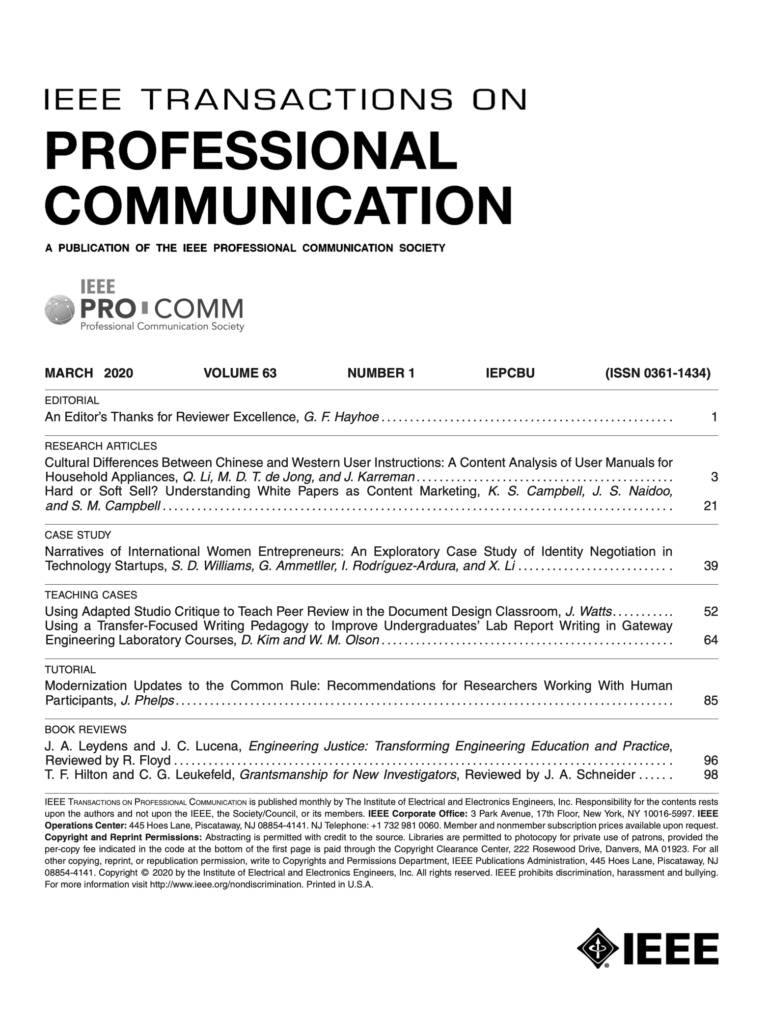Volume 63, Number 1, March 2020 of IEEE Transactions on Professional Communication Now Available!
03 March, 2020
Published on March 3, 2020

| The new issue is now available online! Research Articles: Cultural Differences Between Chinese and Western User Instructions: A Content Analysis of User Manuals for Household Appliances, by Q. Li, M. D. T. de Jong, and J. KarremanThis study investigates differences in document design practices and user preferences, and seeks to answer to what extent and how do Chinese and Western manuals differ from each other in terms of content, structure, and use of visuals. A quantitative content analysis compared 50 Chinese manuals and 50 Western manuals. It found that Chinese manuals are less confined to user support functions than Western manuals. Compared to Western manuals, the structure of Chinese manuals appears to be fuzzier and less rigid. Chinese manuals contain more non-instrumental, entertaining illustrations than Western manuals. Underlying these differences is a more general distinction between highly instrumental Western manuals and more flexible Chinese manuals. These differences seem to point to two cultural dimensions: holistic versus analytic thinking and analog versus digital cultures. Hard or Soft Sell? Understanding White Papers as Content Marketing, by K. S. Campbell, J. S. Naidoo, and S. M. CampbellAlthough some have noted that combining technical and marketing content is precarious, technical communication professionals are increasingly involved in content marketing, which includes the creation of white papers. This study explores the dimensions of hard- and soft-sell appeals that predominate in white papers. In the corpus of white papers that the authors analyzed, hard-sell dimensions were more prevalent than soft-sell dimensions. However, the soft-sell category of “implicitness” was also dominant. The results demonstrate the value of treating hard and soft selling as multidimensional, complementary, and combinatory marketing appeals that allow, for example, a single white paper to be both “subjective” (soft sell), and “precise” (hard sell), or both “creative” (soft sell) and “informative” (hard sell). Case Study: Narratives of International Women Entrepreneurs: An Exploratory Case Study of Identity Negotiation in Technology Startups, by S. D. Williams, G. Ammetller, I. Rodríguez-Ardura, and X. LiBecause female entrepreneurs play a significant role in new business creation, a need exists to “give voice” to their stories. This exploratory case examines the identities that three female entrepreneurs, each from a different culture, express in their narratives. The authors recorded their oral narratives about their entrepreneurial journeys. Analysis suggests that each participant negotiated discourses of entrepreneurship, gender, and culture differently, with the greatest divergence on cultural codes, and the least divergence on gender codes. The results suggest that future research should begin with the assumption that no single “entrepreneurial identity” exists for female entrepreneurs, and more broadly that professional communication research should foreground differences among individuals rather aggregating individual experiences into homogeneous characterizations. Teaching Cases: Using Adapted Studio Critique to Teach Peer Review in the Document Design Classroom, by J. WattsGiven the importance of visual communication to technical communicators’ work, 40% of undergraduate programs in technical and professional communication require a document design course. However, document design pedagogies such as structuring peer review are still being researched, and popular textbooks do not provide instruction about how to facilitate this important pedagogy. In this study, an adapted form of studio critique was used to provide students with design feedback. Surveys and interviews indicate that results were favorable, but the authors recommend extending critique time, better facilitating participation, capturing feedback effectively, focusing the presentation, evaluating feedback, and requesting revision plans. Using a Transfer-Focused Writing Pedagogy to Improve Undergraduates’ Lab Report Writing in Gateway Engineering Laboratory Courses, by D. Kim and W. M. OlsonThe lab report challenges students in meeting writing expectations. Engineering faculty are similarly challenged in teaching lab report writing because they are under-supported in writing pedagogies and unfamiliar with the students’ prior writing knowledge. Four engineering instructors and two English instructors designed and developed a lab report writing instructional module, and implemented its materials in their lab courses. The module, consisting of writing instruction and assessment resources, shares a rhetorical approach and terminology with first-year composition courses to emphasize a writing-transfer pedagogy. Data show that a rhetorical approach helped students better understand the expectations of this discipline-specific genre. It also developed students’ understanding of the rhetorical features of engineering writing and positively impacted the quality of their lab reports. Tutorial: Modernization Updates to the Common Rule: Recommendations for Researchers Working with Human Participants, by J. PhelpsThis tutorial article explicates some of the 2017 updates to the 1991 Common Rule. Implemented in January 2019, these changes impact research with human participants in the U.S. The introduction provides context for the article as well as framing research questions. The lessons for researchers working with human participants include discussion of the impact of policy changes in the Common Rule associated with broad consent, single Institutional Review Board (IRB) mandate/cooperative review, updated exemptions, modified definitions of vulnerability, and international research. These are all contextualized within a specific example for professional communication researchers. |

